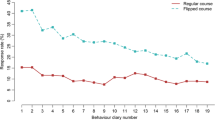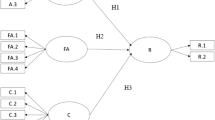Abstract
The flipped classroom has shown a positive effect on academic performance and student satisfaction. However, there are relatively few studies that help us understand when or why this method has a positive effect on students, so as to aid the design of a flipped class. In this study, an instrument for assessing the student learning experience in flipped courses is proposed and validated, comparing the results of their application over two semesters in a university-level programming class with three flipped sections (n = 151) and four conventional ones (n = 226). We found that with a similar score in terms of learning experience, the achievement in a flipped course is slightly higher than in a lecture-based course, F(1,108) = 4.20, p = 0.04, d = 0.19. A multiple regression analysis was conducted for the effect on achievement of GPA, level of challenge, feedback and enjoyment. By controlling for these factors, students in flipped classes achieved higher scores than students in lecture-based courses, β = 0.1, t(370) = 2.4, p = 0.02. The expected improvement in achievement increases when features of the flipped classroom improve the student experience. Our results suggest that the design of a flipped class should consider the effect of different implementation features on student experience in order to select the most appropriate ones for a particular context.



Similar content being viewed by others
References
Adams, E. (2010). Fundamentals of game design (2nd ed.). Berkeley, CA: Pearson Education.
Baepler, P., Walker, J. D., & Driessen, M. (2014). It’s not about seat time: Blending, flipping, and efficiency in active learning classrooms. Computers & Education, 78, 227–236.
Bergmann, J., & Sams, A. (2012). Flip your classroom: Reach every student in every class every day. Washington, DC: International Society for Technology in Education (ISTE).
Bishop, J. L., & Verleger, M. A. (2013). The flipped classroom: A survey of the research. In ASEE National Conference Proceedings, Atlanta, GA (Vol. 30, No. 9).
Campbell, J., Horton, D., Craig, M., & Gries, P. (2014). Evaluating an inverted CS1. In Proceedings of the 45th ACM technical symposium on computer science education (pp. 307–312). ACM.
Chen, Y., Wang, Y., & Chen, N. S. (2014). Is FLIP enough? Or should we use the FLIPPED model instead? Computers & Education, 79, 16–27.
Clark, R. C., & Mayer, R. E. (2011). E-learning and the science of instruction: Proven guidelines for consumers and designers of multimedia learning. San Francisco, CA: Wiley.
Csikszentmihalyi, M. (1990). Flow: The psychology of optimal experience. New York, NY: Harper Perennial.
Deci, E. L., Eghrari, H., Patrick, B. C., & Leone, D. (1994). Facilitating internalization: The self-determination theory perspective. Journal of Personality, 62, 119–142.
Esteban-Millat, I., Martínez-López, F. J., Huertas-García, R., Meseguer, A., & Rodríguez-Ardura, I. (2014). Modelling students’ flow experiences in an online learning environment. Computers & Education, 71, 111–123.
Fang, X., Zhang, J., & Chan, S. (2013). Development of an instrument for studying flow in computer game play. International Journal of Human-Computer Interaction, 29(7), 456–470.
Felder, R. M., & Brent, R. (2005). Understanding student differences. Journal of Engineering Education, 94(1), 57–72.
Field, Andy, Miles, Jeremy, & Field, Zoe. (2012). Discovering statistics using R. London: SAGE Publications Ltd.
Freeman, S., Eddy, S. L., McDonough, M., Smith, M. K., Okoroafor, N., Jordt, H., et al. (2014). Active learning increases student performance in science, engineering, and mathematics. Proceedings of the National Academy of Sciences, 111(23), 8410–8415.
Fu, F. L., Su, R. C., & Yu, S. C. (2009). EGameFlow: A scale to measure learners’ enjoyment of e-learning games. Computers & Education, 52(1), 101–112.
Gross, D., Pietri, E. S., Anderson, G., Moyano-Camihort, K., & Graham, M. J. (2015). Increased preclass preparation underlies student outcome improvement in the flipped classroom. CBE-Life Sciences Education, 14(4), ar36.
Haak, D. C., HilleRisLambers, J., Pitre, E., & Freeman, S. (2011). Increased structure and active learning reduce the achievement gap in introductory biology. Science, 332(6034), 1213–1216.
Hair, J., Black, W., Babin, B., & Anderson, R. (2010). Multivariate data analysis (7th ed.). Upper Saddle River, NJ: Prentice-Hall Inc.
Hattie, J. (2013). Visible learning: A synthesis of over 800 meta-analyses relating to achievement. New York, NY: Routledge.
Hattie, J., & Timperley, H. (2007). The power of feedback. Review of educational research, 77(1), 81–112.
Hayashi, Y., Fukamachi, K. I., & Komatsugawa, H. (2015). Collaborative learning in computer programming courses that adopted the flipped classroom. In 2015 International conference on learning and teaching in computing and engineering (LaTiCE) (pp. 209–212). IEEE.
Horton, D., & Craig, M. (2015). Drop, fail, pass, continue: Persistence in CS1 and beyond in traditional and inverted delivery. In Proceedings of the 46th ACM technical symposium on computer science education (pp. 235–240). ACM.
Hox, J. J., Moerbeek, M., & van de Schoot, R. (2010). Multilevel analysis: Techniques and applications. New York, NY: Routledge.
Jenkins, T. (2002). On the difficulty of learning to program. In Proceedings of the third annual conference of the LTSN centre for information and computer sciences (Vol. 4, pp. 53–58).
Jensen, J. L., Kummer, T. A., & Godoy, P. D. D. M. (2015). Improvements from a flipped classroom may simply be the fruits of active learning. CBE-Life Sciences Education, 14(1), ar5.
Karahoca, A., Karahoca, D., & Yengin, İ. (2010). Computer assisted active learning system development for critical thinking in history of civilization. Cypriot Journal of Educational Sciences, 5(1), 4–25.
Kim, M. K., Kim, S. M., Khera, O., & Getman, J. (2014). The experience of three flipped classrooms in an urban university: An exploration of design principles. The Internet and Higher Education, 22, 37–50.
Koulouri, T., Lauria, S., & Macredie, R. D. (2014). Teaching introductory programming: A quantitative evaluation of different approaches. ACM Transactions on Computing Education (TOCE), 14(4), 26.
Law, E. L. C., van Schaik, P., & Roto, V. (2014). Attitudes towards user experience (UX) measurement. International Journal of Human–Computer Studies, 72(6), 526–541.
Mason, G., Shuman, T., & Cook, K. (2013). Comparing the effectiveness of an inverted classroom to a traditional classroom in an upper-division engineering course. IEEE Transactions on Education, 56(4), 430–435.
McLaughlin, J. E., Roth, M. T., Glatt, D. M., Gharkholonarehe, N., Davidson, C. A., Griffin, L. M., et al. (2014). The flipped classroom: A course redesign to foster learning and engagement in a health professions school. Academic Medicine, 89(2), 236–243.
Nakamura, J., & Csikszentmihalyi, M. (2014). The concept of flow. Flow and the foundations of positive psychology (pp. 239–263). Berlin: Springer.
Niemiec, C. P., & Ryan, R. M. (2009). Autonomy, competence, and relatedness in the classroom: Applying self-determination theory to educational practice. Theory and Research in Education, 7(2), 133–144.
O’Flaherty, J., & Phillips, C. (2015). The use of flipped classrooms in higher education: A scoping review. The Internet and Higher Education, 25, 85–95.
Pedhazur, E. J. (1997). Multiple regression in behavioral research: Explanation and prediction. Fort Worth, TX: Harcourt Brace College Publishers.
Prince, M. (2004). Does active learning work? A review of the research. Journal of Engineering Education, 93(3), 223–231.
Ryan, R. M., & Deci, E. L. (2000). Self-determination theory and the facilitation of intrinsic motivation, social development, and well-being. American Psychologist, 55(1), 68.
Shernoff, D. J., & Csikszentmihalyi, M. (2009). Flow in schools: Cultivating engaged learners and optimal learning environments. In R. Gilman, E. S. Huebner, & M. Furlong (Eds.), Handbook of positive psychology in schools (pp. 131–145). New York, NY: Routledge.
Shernoff, D. J., Csikszentmihalyi, M., Shneider, B., & Shernoff, E. S. (2003). Student engagement in high school classrooms from the perspective of flow theory. School Psychology Quarterly, 18(2), 158.
Stevens, J. P. (2009). Applied multivariate statistics for the social sciences. New York, NY: Routledge.
Tabachnick, B. G., & Fidell, L. S. (2013). Using multivariate statistics (6th ed.). Upper Saddle River, NJ: Pearson Education Inc.
Van Gog, T., Ericsson, K. A., Rikers, R. M., & Paas, F. (2005). Instructional design for advanced learners: Establishing connections between the theoretical frameworks of cognitive load and deliberate practice. Educational Technology Research and Development, 53(3), 73–81.
Vygotsky, L. S. (1978). Mind in society. Cambridge, MA: Harvard University Press.
Walker, D. A. (2003). JMASM9: Converting Kendall’s tau for correlational or meta-analytic analyses. Journal of Modern Applied Statistical Methods, 2(2), 26.
Wirkala, C., & Kuhn, D. (2011). Problem-based learning in K–12 education is it effective and how does it achieve its effects? American Educational Research Journal, 48(5), 1157–1186.
Acknowledgements
This work was funded by grant CONICYT-PCHA/doctorado Nacional/2013-21130045, FONDECYT-CONICYT 11150231 and the MOOC Maker EU Project (561533-EPP-1- 2015-1-ES-EPPKA2-CBHE-JP).
Author information
Authors and Affiliations
Corresponding author
Ethics declarations
Conflict of interest
The authors have no conflict of interest in the execution or outcomes of this study.
Appendix
Appendix
Rights and permissions
About this article
Cite this article
Schwarzenberg, P., Navon, J., Nussbaum, M. et al. Learning experience assessment of flipped courses. J Comput High Educ 30, 237–258 (2018). https://doi.org/10.1007/s12528-017-9159-8
Published:
Issue Date:
DOI: https://doi.org/10.1007/s12528-017-9159-8




